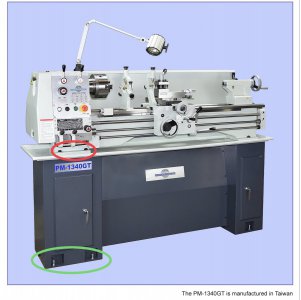- Joined
- Apr 20, 2019
- Messages
- 166
@Titanium Knurler , how did your stand work out? Are you able to move it and not have the alignment of your lathe needing to be re-adjusted?
I tried aligning my PM-1224T for twist and it was hard to see any difference. I didn’t know if to put it down to bad technique or the more rigid 24” bed……it moved easily and stayed aligned…
I tried aligning my PM-1224T for twist and it was hard to see any difference. I didn’t know if to put it down to bad technique or the more rigid 24” bed…
Hi Tim,So, I'm getting around to really trying to align the lathe. When I first got it, I leveled/took the twist out of the ways. Now that I have had it for a while and spend a little time learning how to run a lathe. I have decided it is time to re-address the alignment. I have learned that when I thought I had it level I had performed the function incorrectly. That being said I don't know if I ever had it correct. I had laid my precision level across the V-Ways.
So, my one question before I get head deep into this alignment issue. On the headstock end there are four feet, do they adjust the headstock up and down in relationship to the tailstock? You may have covered it earlier in this thread, I'm back on page 18 still trying to absorb all the information.
Tim

Firstgear- have you ever run the BBORR (Big Bend Open Road Race)? I've been running it since 2012. Started in 115 class and now run the 130. As you know, it's a blast!That was my wife and I last September running in the 105 mph class at the Silver State Classic run in Nevada. They close off 90 miles of two lane highway and your goal is to average your class speed over the 90 miles. Our target time was about 51 minutes and 25.714 seconds. We won our class, we were slow by 0.0373 seconds. She has two stop watches and every mile tells me if we are fast or slow and by how much. With a half mile to go she figured we were 0.100 seconds slow, so By the time everything computed in my head, I pushed the speed up to 118 mph.
We trailered the car from Ohio, 5,000 miles round trip. My Corvette is a 2015 Z06 with some mods, it has 620hp and 635 ft-lbs at the rear wheels. The record run over the 90 miles was in the unlimited class and that car averaged 217mph with a top speed of 242 mph. That was done by a repurposed NASCAR car.
I am glad to see your solution included casters. I put them on the PM-728VT and plan to use them with the TM-1236. https://www.amazon.com/gp/product/B09V6GCLXN/ref=ppx_yo_dt_b_search_asin_title?ie=UTF8&psc=1I. Unpacking, cont’d
If you look at the photo of the stand in the last post you will see that the headstock side has four areas for support at the base for leveling mounts and four at the top to mount the lathe to the cabinet. Similarly, the tailstock end has two. The PM Manual recommends that if one uses leveling mounts that they should be rated for 250 lb each. Since I was planning on adding casters and machine mounts for the mobile base I wanted to get a pretty good idea of the weight of the headstock and tailstock ends. I used a trailer tongue weight scale to determine the approximate weight while the lathe was on the pallet.
View attachment 285417. View attachment 285418
As you can see this is a pretty good recommendation:
View attachment 285419. View attachment 285420
View attachment 285421. View attachment 285422
If you fast forward to when the stand is complete and the lathe is mounted on the mobile base you can see that the 250 lb/mount recommendation is still pretty reasonable:
View attachment 285423. View attachment 285424
View attachment 285425. View attachment 285426
However, as you will see in the next section I used casters and mounts that are rated for at least fours times that amount.
Well, enough about Unpacking. I promised at the beginning I would list what I(TK) would do differently and would make recommendations for the manufacturer,Liang Dei(LD) and PM. So here they are:
TK- none this time but there are plenty coming up
LD-better packing to avoid scuffs and scratches
-better engineered latches or at least ones that do not need to be modified
-COSMOLINE TO THE SPINDLE BORE
PM-get labels correct, straight and centered
-make touch-up paint available
Pretty minor stuff. Next I will discuss making the mobile base. I am very interested in your feedback on this!
